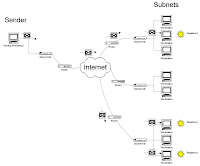Unicast Address is one-to-one. Is the most common type on the IP network. For a unicast packet to be sent and received, a destination IP address must be in the IP packet header. A corresponding destination MAC address must also be present in teh Ethernet fram header. The IP address and MAC address combine to deliver data to one specific destination host. If the destination IP address is on another network, the initial destination MAC address used in the fame is that of the router interface on the same network as the source IP.
Multicast Address is one-to-many. Allows a source device to sen a packet to a group of devices. Devices that belong to a multicast group are assigned a multicast group IP address. The range of multicast addresses are 224.0.0.0 to 239.255.255.255. Multicast Addresses can only be used as the destination of a packet because they represent a group of addresses (also called a host group). Needs a special corresponding multicast MAC address that begains with 01-00-5E in hexadecimal.
Broadcast Address is one-to-all. The packet contains a destination IP address of all 1s in the host portion. That means that all hosts on that local network will receive and look at the packet. Many network protocols, such as ARP and DHCP, use broadcasts. A broadcast IP address for a network needs a corresponding broadcast MAC address in the Ethernet frame. On Ethernet networks, the broadcast MAC address is 48 ones displayed as hexadecimal FF-FF-FF-FF-FF-FF.




No comments:
Post a Comment